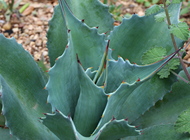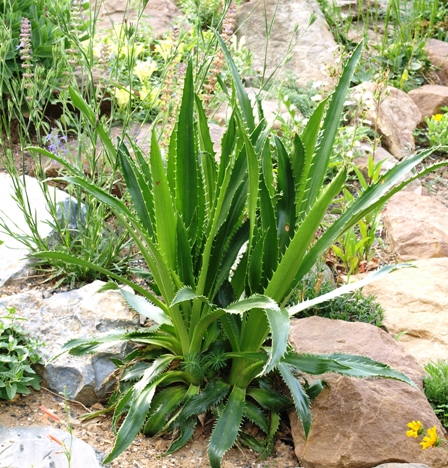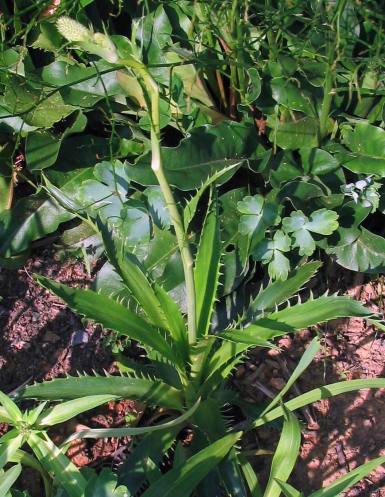 |
Eryngium agavifolium |
 |
| Common name |
agave-leaved sea holly |
| Family |
apiaceae |
| Life cycle |
perennial (Z4-9) |
| Flowers |
white |
| Size |
3 ft |
| Light |
full sun |
| Cultural notes |
well-drained soil |
| Seed ripens | early August |
We grow this Argentinian species primarily for the impressive foliage – rosettes of fleshy, bright green slightly spiny strap-shaped leaves. The flower stalks in summer carry whitish pom-poms, not unlike their cousins Eryngium yuccifolium. The plants are more finnicky than most eryngiums we grow, though; the photo above right is of an older divided plant that isn't so happy about its lot, hence the scraggly, bent flower stalk. In almost all of my experience, the plants arranges its rosette fairly low to the ground, the leaves not going upward as much as outward – but our current largest specimen, planted in the rock garden, has developed a much more upright habit. Sometimes even plants that have been in the garden for years surprise you with something new!
Several years after moving to Texas, I figured I'd try my luck with them in this hotter climate. I managed to get some seedlings going, and kept three of them alive through their first year, which l set in our rock garden zone in early spring. They looked lovely, until I noticed they had suddenly turned brown after a few weeks of hot dry weather. They may look as tough as agave, but it seems they can't take the heat to the same extent.
|

| | I loved this image that caught my eye in the late-November garden - its fresh-green, plump foliage surrounded by the scattered purple-brown pear leaves |
| 
| | Texas specimen in the aftermath of its sudden decline due to hot dry weather |
|
This plant used to grow in our garden, but it slipped away... Read about all the eryngium species in our garden One or more images of this plant are included in my stock photo catalog About my plant portraits
PlantLinks to other web pages about Eryngium agavifolium
Visitors to this page have left the following comments| Sheila Sweeton | Oct 03, 2009 | I have my first of this plant and not a clue how to care for it. I finally figured out I was not giving it enough water but now winter is comeing on and the tall stalk has turned brown and new green leaves have appeared at the bottom. I live in the Willamette Valley in Oregon and my winters do get coldl Do I cut the stalk, do I cover it? Perhaps you would send me some directions to help keep it from dying this winter. Thank You
Your plant should do fine without special treatment - just be sure the soil around it doesn't get waterlogged in winter. Our winters are colder than yours, and some of our plants have come through many sub-zero seasons. |
- Seed from T&M. 35F (7w) - 70F (7%G, 2w)
- Seed from '00 garden. No G
- Seed from '01 garden. Baggy 35F (6w) - 70F (7d) - 70F with light (18%G, <7d)
- Seed from '02 garden. Baggy 35F (8w) - 70F (5w; light after 11d; no G)
- Seed from '05 garden. Baggy 35F (7w) - 70F (19d) - 70F with light (13d; no G)
- Seed from '06 garden - two attempts. Baggy 65F with light (6w; 3%G, 9d). Baggy 35F (8w) - 65F (30d; 8%G, 11-17d)
- Seed from '07 garden (harvested August) - Baggy 35F (9w) - 70F (63%G, 6-12d)
- Seed from '07 garden. Baggy 35F (9w) - 70F (34%G, 6-18d)
- Seed from '07 garden. Baggy 35F (9w) - 70F (33%G, 6-15d)
- Seed from '10 garden. Baggy 35F (8w) - 70F (no G, 5w)
- Seed from '12 garden. Baggy 35F (8w) - 70F (3%G, 7-9d)
- Same seed as above, cold-stored. Baggy 35F (8w) - 70F (7%G, 8-11d)
- Same seed as above, cold-stored. Baggy 35F (9w) - 70F (1/many G, 6d)
- Seed from NARGS '19/'20 exchange. Baggy 35F (8w) - 70F (44%G, 5-10d)
- Same seed as above. Baggy 35F (8w) - 70F (80%G, 6-15d)
Not sure if poor rate of success is due to seed viability or germination methodology. Comparing the results from 2007, the cold treatment method may give somewhat higher success rate. The anomalously high germination rate in 2008 may have been better seed, or perhaps the slightly longer cold treatment helped. In my experience, many seeds that sprout don't develop into viable seedlings - still working on the best procedure to improve success.
I welcome comments about my web pages; feel free to use the form below to
leave feedback about this particular page. For the benefit of other visitors
to these pages, I will list any relevant comments you leave, and if
appropriate, I will update my page to correct mis-information. Faced with an
ever-increasing onslaught of spam, I'm forced to discard any comments including
html markups. Please submit your comment as plain text. If you have a
comment about the website as a whole, please leave it in my
guestbook. If you
have a question that needs a personal response, please
e-mail me.
Last modified:
May 22, 2022
Contact me
|







